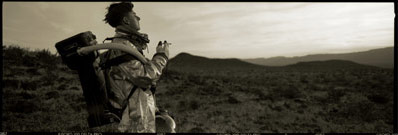weep not for the future: the photographs of Sam Davis
•
Curator's Statement by Liz Murphy Thomas

Agua Dulce, CA is located about an hour’s drive north of the epicenter of American film making – Hollywood, CA. It is an unincorporated town with approximately 4,000 residents. Not far away natural sandstone formations, known as the Vasquez rocks, were used by a Californio bandit (Tiburcio Vasquez, for whom the rocks were named) in the 1800’s as a hideout to escape law enforcement. Since that time the rocks have also been used by generations of film makers hoping in another way to escape, hoping to portray a landscape that could break free of earthly locations and create the illusion of someplace otherworldly.
This seems like a fitting metaphor for beginning to think about Sam Davis’ work. The fact that these iconic, easily identifiable rocks have been used over and over again in countless films, television shows, videos and still photographs speaks to a collective suspension of disbelief that extends beyond that already entertained by visual fictions. It’s a classic simulacrum, the desert and these rocks become “outer space,” but their frequency in representation concedes their truth – these rocks were most likely a convenient jaunt outside the city in which a great majority of films and television series were produced.
Suspension of disbelief works because we want to believe. We want, as a young Sam most likely did, to live in a future where the promises of science fiction became reality. Sam’s work, inspired in part by his childhood proximity to a naval air station, has a nostalgia that is both autobiographical as well as universal. It is easy to imagine a young Sam witnessing military flights near his home, watching science fiction films and cartoons and playing with toys fashioned after those icons of fiction and fantasy. It is easy to imagine because, perhaps with the exception of witnessing flights, Sam’s history is also our own history, our own collective childhood.
Some say the space age is over. Packed up and put away like the toys and dreams of youth, NASA's manned missions to space will cease tentatively on July 8th, 2011 when the space shuttle Atlantis launches for the last time to bring supplies to the international space station. Soon the fantastic visualizations of space travel will be just as distant as they were when first imagined over 50 years ago. Sam’s photographs invoke both a memory of these early hopes as well as the sad realization they have never been fully realized. We went to the moon, but we did not stay.
In developing an exhibition of Sam’s work it was important to balance the elements of nostalgia, disappointment and memory they invoke. The series Tragic Heroes re-imagines the ubiquitous and virulent protagonist of so many sci-fi films instead as flawed, tentative and mortal. The desert and costumes, once convincing as an alien environment are in Davis’ images revealed as props and costumes. Contrails betray the airspace above as mundane  sky filled with commuter planes. The lone figure, in a shiny suit and in an inhospitable environment, removes his helmet to smoke a cigarette and becomes a photographic outtake – a continuity error. There is disappointment in the realization that our hero is a fallible figure, but there is also a tongue-in-cheek nod to a film cliché, the pretense of breathable air on an abundance of alien planets.
sky filled with commuter planes. The lone figure, in a shiny suit and in an inhospitable environment, removes his helmet to smoke a cigarette and becomes a photographic outtake – a continuity error. There is disappointment in the realization that our hero is a fallible figure, but there is also a tongue-in-cheek nod to a film cliché, the pretense of breathable air on an abundance of alien planets.
Davis’ series Tin and Sculptural Objects play even further with the punctum of nostalgia. Utilizing various nineteenth century photographic processes to record atomic-era “devices” – devices which he himself has cast - Davis toys with our sense of chronology and ultimately our sense of veracity. Robots, “ray guns,” rocket ships and UFOs are all presented as evidentiary proof of the impossible.
This exhibition, weep not for the future, features work from Davis’ Tragic Heroes, Tin and Sculptural Objects series. Together they evoke a sense of false nostalgia for an age that is both familiar and yet unknown. Viewing Davis’ work, one experiences a sense of melancholy and well as absurdity. The experience culminates in a sense of loss as well as a sense of being an outsider – we feel late to the party that has yet to exist.
© Copyright 2011 by Liz Murphy Thomas. All rights reserved.